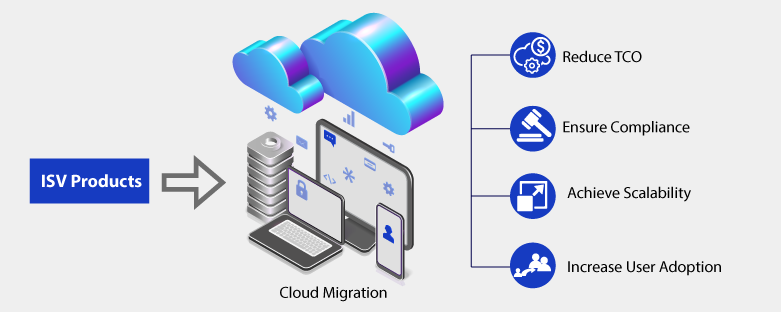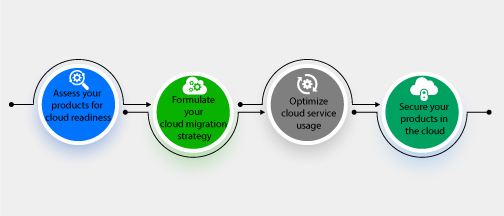



4 Steps to Simplify Cloud Migration for NextGen ISV Products
By Yogesh Sharma, Technical Architect – Delivery Engineering
Global demand for SaaS offerings and better cost optimization are driving cloud adoption and migration. Software providers moving aggressively to the cloud are emerging as NextGen ISVs, laser focused on helping customers optimize scalability with SaaS and control costs with the innovative licensing and flexible subscription models available with cloud.
Gartner predicts the worldwide public cloud service market will grow from $182.4B in 2018 to $364B in 2022.1
For both NextGen ISVs and their enterprise clients, cloud adoption and migration extend their market landscapes to new global customers and revenue opportunities. However, migration from traditional on premise to cloud involves a radical shift in business models and numerous technical challenges. In this blog, we discuss what ISVs expect from cloud migration and a 4-step approach to simplify their cloud migration journeys.
ISV Expectations from Cloud Migration
Cloud migration is one of the cloud enablement pathways for NextGen ISV product development and delivery. The legacy approach required significant time and costs for server maintenance and physical security, new server procurement for major tenants or multi-tenants, increased network security, frequent OS patching, etc. In the cloud, the operational issues for managing products diminish as activities like server management, backup management, etc. are offloaded to the cloud services provider (CSP).

Cloud Migration Benefits for NextGen ISV Products
Today’s NextGen ISVs are hand-picking cloud services from a basket of offerings with expectation of the following cloud migration benefits:
- Reduce TCO and time to market, boost profits, and expand user base - These benefits are typical, but also contingent upon how effectively ISVs leverage their CSP’s services. For example, the TCO depends on the level and type of IaaS or PaaS services the ISV uses to deliver the SaaS offerings their customers require.
- Ensure product resiliency - Support and extend product value by leveraging cloud platform services like device farms, advanced analytics, Natural Language Processing, autoscaling, pay as you go, continuous compliance, low code platform capabilities, and many more.
- Achieve rapid development using cloud security and compliance services - GDPR, FHIR and other country-specific compliances are effectively supported by major cloud providers (reducing painful hair-pulling by ISV Legal and Engineering teams).
4-Step Cloud Migration Approach for ISVs
By 2022, 90% of enterprises globally will depend on a mix of cloud and/or on-premise infrastructure.2
Decisions on whether to go hybrid cloud, multi-cloud, cloud only, etc. are critical for software vendors who need the on-demand capabilities provided by CSPs to deliver cloud-ready, competitively priced products at digital speeds.
NextGen ISVs can adopt the following 4-Step approach to ensure seamless cloud migration for their products.

STEP 1: Assess your products for cloud readiness
Understand your cloud needs by assessing current capabilities and evaluating future needs from a business stakeholder’s perspective. A few ideas to help you brainstorm those needs:
- For IoT-enabled products, should we use the IoT gateway of a cloud services provider such as Azure or build our own IoT stack?
- Should we use containerized orchestration by open-source platforms like Kubernetes?
- Should we opt for managed services such as managed databases? If so, how do we identify the best candidates?
|
Here’s a checklist to ensure a comprehensive assessment of current applications for cloud migration:
|
STEP 2: Formulate your cloud migration strategy
Based on the assessment findings from Step 1, identify the best strategy for managing workloads and maintaining performance during cloud migrations:
- Hybrid cloud strategy
Initially, a hybrid cloud strategy is the right choice to increase enterprise client confidence by demonstrating a strategy of early adoption of new cloud technology and reduction of TCO. Here, follow a progressive transformation approach by first using low hanging fruit like API gateways, compute services, etc.
- Multi-cloud strategy
To avoid cloud vendor lock-in, apply a multi-cloud strategy. Multi-cloud helps in using different capabilities of public cloud for which they are leaders. Ex: Use machine learning algorithm from cloud provider ‘A’ as they are leader in it. Integrated ecosystem capabilities like messaging services, email, etc. can be from cloud provider ‘B’.
Choosing the right cloud migration path for your product transformation
As per the assessment study in Step 1, you can explore several cloud migration methods for your product transformation. A few of them are listed below:
- Rehosting:
Often known as lift and shift, the method is used when an ISV needs a quick move from on-premises to cloud or from one cloud to another. The NextGen ISV can re-architect the workload later for further optimizations and to leverage other cloud offerings. Progressive shift is appropriate when rehosting a solution that’s limited to users of certain geographies, instead of the global user base. Another good example is shifting independent services like user registration/sign-up services or bulk file processing services.
- Refactoring:
Some applications require minimal transformation to connect to cloud services from a scalability perspective. Here, ISVs may apply next-gen expertise to use the cloud’s PaaS capabilities. Ex: Using cloud-hosted DB services instead of video streaming, integration, analytics services, etc.
- Rearchitecting:
Investigate how you can transform the existing application to use cloud-native services. Consider your goals from a time-cost perspective. Rearchitecting the complete application is time-consuming and garnering stakeholder support can be difficult. To avoid these bottlenecks, NextGen ISVs are using cloud-native approaches like autoscaling, dynamic orchestration services, elastic computing and serverless computing to increase scalability and sustainability and reduce costs.
Examples:
- Transformation of monolithic to a microservices architecture – Use of serverless architecture to reduce 24x7 cost on dedicated VMs and to achieve event-driven architecture.
- Add Web 3.0 in applications using the AI/ML capabilities of public cloud providers.
- Messaging service capabilities.
- Repurchasing/Reintegrating:
Leverage existing SaaS application to simplify certain components of the application. This pattern puts emphasis on solving the migration puzzle by using market capabilities.
Examples:
- Device Farm service from your cloud provider: instead of investing in mobile devices just to test your app, use a cloud SaaS offering.
- Utilize the CSP’s DevOps services to quickly stand up required build pipelines.
STEP 3: Optimize cloud service usage
In this stage, focus on re-validating transformed solutions by simplifying cloud service usage for your products and/or by closely monitoring these services. For instance, use a cost calculator to track monthly spending on specific services.
Cloud migration is not just about infrastructure transformation projects. Optimum use of your cloud provider’s services should be a best practice for improving products and making them more flexible and resilient. For instance, if you use the lift and shift migration method, you will have opportunities to perfect certain mechanisms.
Let’s say you wrote a ML algorithm for a custom-built product. When you move to the cloud, think about using a readily available solution like Google AI to enhance your cloud-based product and make it more scalable. That’s how you achieve continuous optimization.
Another useful practice is finetuning overused services or applying a different pattern. Consider auto-shutdown of services when they are not in use. Scale services up or down as per the consumption patterns of product users. For instance, consider the scalability required to meet the load of increased consumption of a B2B retail product during holidays.
Step 4: Secure your products in the cloud
Security is paramount for any ISV. All cloud service providers store data at REST in a secured manner. Here, multiple replicas based on the ISV’s consensus can be created. If you use cloud services globally for your products, cloud migration enhances your security capabilities. Cloud providers manage the complete IaaS security internally to protect ISV products and ensure country-specific compliance.
Also, consider tailored security solutions for your software products on case-to-case basis. Cloud security experts can add end-to-end encryptions to implement extra security layers between the software vendor and the enterprise client. Or create a custom certificate management module for all customers, including DSC and SSL certifications.
Partner with Xoriant to:
- Maximize your success
- Reduce time to market
- Benefit from our experience in developing and securing products in the cloud
- Leverage our deep understanding of platform architecture and building for scalability and agility
To discuss support for cloud migration with Xoriant experts, write to PE@Xoriant.com
References:






 View Previous Blog
View Previous Blog




